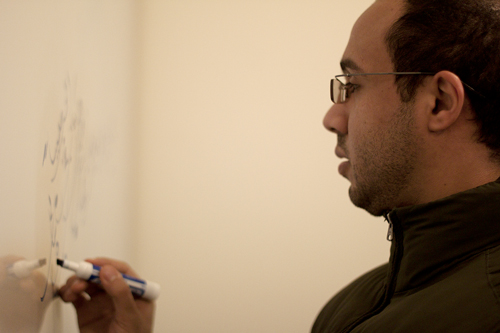
Students stepping into the Millar Library for the first time since the end of fall term will undoubtedly notice the library’s newest addition: the Sandbox. Portland State’s new collaborative technology space, the Sandbox, is a component of the redesigned Learning Ground that opened in the fall. It is an enclosed space that connects to the bustling computer lab on the first floor. The Sandbox opened Jan. 10 and features adjustable tables, floor-to-ceiling magnetic whiteboards and LCD displays that are for use with laptops and tablets.
Nathan Mealey, manager of library technologies at Millar Library, supervised the Learning Ground renovation project. Mealey worked in collaboration with the Department of Facilities and Planning and Carleton Hart Architecture to design the space.
In an email, Mealey explained the reasons for the Learning Ground renovation and construction of the Sandbox. “The computer lab on the first floor,” Mealey wrote, “has always been a very busy, popular space on campus, and this project sought to improve the facilities it offered.” The Sandbox provides students with access to an array of technologies designed to facilitate study and group collaboration.
According to Mealey, the Sandbox will help the library and the Office of Information Technology learn which technologies students benefit from and utilize most so they can be implemented elsewhere on campus.
Isaac Hotchkiss, a senior English major, works in the library’s new computer lab. He thinks it’s a good space, though he believes there is a drawback in the fact that it can’t be reserved. “You can’t count on being able to use it,” Hotchkiss said.
According to Hotchkiss, the room is frequently used by groups of three or four students who set up at tables and use their own laptops. However, as Hotchkiss pointed out, students aren’t using the touch screens. “It’s a new space,” Hotchkiss said, “students don’t know about it or how to use it.” There are policy issues that still need working out, Hotchkiss added.
“I probably won’t use it,” said Julian Honeycutt, a junior international studies major. Honeycutt visits the library nearly every day to study on the fourth floor, a designated quiet floor. It surprised him upon returning from winter break to see that the lounge in front of the coffee kiosk on the library’s first floor had been turned into an expensive-looking study space.
Honeycutt noted that the space “doesn’t seem all that different from other study spaces in the library.” He thinks more could have been done to promote the Sandbox. “I’ve been in there,” Honeycutt said, “and I still don’t know what it does or what it’s all for.”
Honeycutt wonders about the benefit of investing money in such a project while other corners of the school apparently need improvement and are neglected. “There are buckets under the leaking ceiling in the basement hall that connects Smith and Cramer that have been there for a week,” Honeycutt said. “Why is money going to build new study spaces?”
The Learning Ground project cost nearly $700,000 altogether. While OIT and the library itself put forward some of the funding for the project, the lion’s share—$494,000—came from ASPSU. Representatives from ASPSU did not respond to repeated contact attempts.
The Sandbox is open during the library’s normal hours and is open to students on a first-come, first-serve basis.

